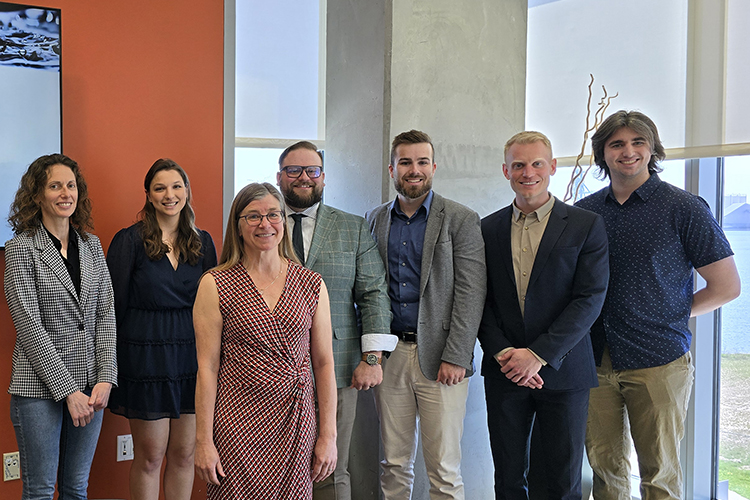Is achieving net zero emissions in the water sector possible? That’s the question UW-Milwaukee students hoped to answer during the School of Freshwater Sciences spring “Freshwater Practicum” graduate-level course. The course simulates working in a water consulting firm and connects students to a public sector client to research real-world water challenges and offer recommendations.
“Alongside applying their research skills to help a client, the students meet 10 leading water consultants during the semester to learn about the business of consulting and build their professional networks. This course helps transition the graduate students into the workforce,” according to Professor Melissa Scanlan.
In May, students Cody Crist, Carley DeLong, Alex Gregory, Isaac McCready, and Alex Miller presented findings to their client: the Great Lakes and St. Lawrence Cities Initiative (Cities Initiative). The Cities Initiative aims to establish a program that would help water utilities along the Great Lakes work toward net zero greenhouse gas emissions.
Not only did the students determine that net zero emissions could be possible, but they also developed recommendations that provide the Cities Initiative with a toolkit of strategies to support water utilities in their transition.
Emissions data analyzed indicate that although water utilities produce a relatively small amount of overall CO2 emissions in the United States and Canada, they are a significant source of two other greenhouse gases (GHG): methane and nitrous oxide. In addition, water utilities are a top user of energy, and energy consumption in the water treatment sector is projected to double by 2040.
“Thus, it will be essential for municipalities to understand the role water utilities play in their GHG emissions and energy demands, and the opportunities for greater efficiency,” the report states.
Students identified cities along the Great Lakes that have an opportunity to upgrade wastewater treatment systems to improve water quality in the most energy efficient ways and to simultaneously work toward net zero — including Buffalo, N.Y., and Cleveland and Toledo, Ohio. They discussed current restructuring plans that will help these cities upgrade and transition to cleaner systems.
They also highlighted municipalities that have already implemented technologies and changes that support sustainability and can be used as case studies, including Denver, Colo.; Portland, Ore.; Washington, D.C., Milwaukee, Wisc.; and San Francisco in the United States and Toronto and Montreal in Canada.
The research showed that the most effective strategies for reducing emissions, and in some cases operational costs, include
- upgrading wastewater facilities around the Great Lakes region with anaerobic digestors,
- utilizing biosolids as nutrient-rich fertilizers for agriculture,
- installing solar panels and wind turbines to generate onsite renewable energy, and
- utilizing green infrastructure to minimize and reuse stormwater runoff.
“Utility leaders on the Great Lakes and St. Lawrence Seaway such as Montreal, Toronto, and Milwaukee show that a change towards more sustainable practices is possible, and additional cities, with the right guidance and support, can become leaders as well,” the students wrote in their report.
Acknowledging the costs and time to implement the recommendations, the report suggests a strategic approach that prioritizes upgrading the most out-of-date systems, particularly those municipalities using combined sewer systems. These systems traffic wastewater and stormwater through the same piping and may require overflow events during which stormwater and untreated wastewater are pumped into local waters.
The students identified possible sources of federal funding, including specific programs run by the U.S. Department of Agriculture, Environmental Protection Agency, Department of Housing and Urban Development, and Economic Development Administration.
The report also acknowledges that local municipal codes are often outdated, unclear and may inadvertently restrict green infrastructure. Addressing policy barriers requires a concerted effort from government agencies, industry stakeholders, and local communities. That said, the United States and Canada recently made significant commitments, including the Bipartisan Infrastructure Law, to invest in renewable energy projects and create policy that incentivizes adoption.
“We hope that the research discussed in this report gives the Cities Initiative a steppingstone from which they can begin a program to aid municipalities work toward net zero emissions,” the students wrote.
Is your organization interested in being a client for an upcoming Freshwater Practicum? Contact Melissa Scanlan at waterpolicy@uwm.edu to discuss whether your research needs would be a good fit.
Written by Heidi Jeter, Marketing & Communications Lead, Freshwater Collaborative of Wisconsin
